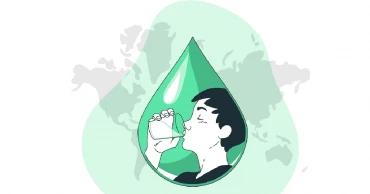water
Should You Drink Hot or Cold Water?
The temperature of water you drink can affect your body in various ways, but there isn't a definitive answer to whether it's better to drink warm or cold water. It depends on your personal preferences, the situation, and your health.
Benefits of Drinking Warm Water
.
Helps Digestion
Warm water can help break down food in the stomach, making digestion easier. It stimulates the digestive enzymes, which can lead to smoother digestion. Drinking warm water before meals may help to prepare your stomach for digestion.
But you shouldn't drink too much hot water. Because, regrettably, hot water can cause damage to the tongue, palate, and stomach tube. The long-term damage brought on by hot foods and drinks may also make people more susceptible to esophageal cancer.
Read more: How to Avoid Winter Weight Gain
Relieves Congestion
If you're dealing with nasal or chest congestion, warm water can help loosen mucus, making it easier to expel. It can also soothe a sore throat and help clear out blockages, providing comfort when you're feeling under the weather.
Improves Blood Circulation
Warm water can promote better blood circulation by expanding blood vessels, improving oxygen delivery to tissues, and helping to remove toxins from the body. This can enhance overall circulation, which benefits your heart health and overall well-being.
Helps Prevent Constipation
Drinking warm water may stimulate bowel movements and prevent constipation. It can help soften stool and make it easier to pass, promoting regularity.
Read more: How to Fix Your Sleep Routine: Know the Do's and Don'ts
Soothes Menstrual Cramps
For women experiencing menstrual cramps, warm water can provide comfort. It helps relax the abdominal muscles and ease cramping, providing relief during menstruation.
Improves Sleep Quality
Drinking a cup of warm water before bed can help you relax and prepare for sleep. It helps calm the nervous system and may promote better, deeper sleep.
11 months ago
How to Build Dhaka as a Water Wise City
Benjamin Franklin says "When the well's dry, we know the worth of water." This seems very true for many urban areas and cities in the world.
The mega city Dhaka is experiencing a severe water crisis in recent years. Water shortage becomes worse during the summer months. The groundwater table is diminishing at an alarming rate. Is it too late to achieve water sustainability in Dhaka?
Groundwater Depletion Scenario in Dhaka
At present, Dhaka has around 21 million people, which is projected to cross 32 million by 2035. Uncontrolled migration and rapid urbanisation are generating diverse problems, including the water crisis.
Dhaka Water Supply and Sewerage Authority (Wasa) is failing to supply water to fulfil the demand of residents in half of the areas of the capital city of Bangladesh.
Dhaka WASA's 2018-19 year's annual report shows that the daily water demand of Dhaka city is about 2.45 billion litres and 78% of this demand is met by groundwater extraction. Besides these, thousands of private deep tube wells are used in the city to extract water from the underground aquifers. Then surface water sources like rivers and lakes are used to fulfil the remaining 22% demand of water.
Read more: Top Strategies to Enhance Fire Resilience in Dhaka City
Most of The rivers and water bodies in and around the capital city including Turag, Dhaleswari, Buriganga, Tongi Khal, Balu, Shitalakshya, Bangshi River, etc are highly polluted by waste materials disposed of industrial as well as municipal sources. This situation aggravates during the dry seasons.
At present, Dhaka WASA has four plants for treating water. But the amount of treated water is quite insufficient compared with the total demand of water.
The long-term dependency on the underground aquifers has taken a toll on the city's groundwater table. According to 2030 Water Resources Group, Dhaka's groundwater table is declining at a rate of 3 metres every year.
If the demand for water increases at the present rate, which is likely, then the projected yearly depletion rate of groundwater reserves can reach up to 5.1 metres by 2030. Currently, the average depth of Dhaka's groundwater table is about 78 metres, which may sink down to 132 metres in the next 10 to 12 years. Without appropriate preventive measures, the groundwater table may plunge to 100 to 150 metres by the year of 2050.
Read more: What Can Dhaka Learn from the Smart City Singapore
Multifarious Effects of Water Crisis
The depletion of underground water levels can affect the residential, commercial and industrial zones of Dhaka city.
The unregulated use of groundwater, may lead to severe shortfall in the supply of drinking water from underground aquifers.
2 years ago
No let-up in safe drinking water scarcity in Khulna’s Dacop
Over 2 lakh residents of salinity-hit Khulna’s Dacop upazila have been grappling with a severe shortage of safe drinking water since the onset of the dry season.
Long queues have become a common sight at shops selling purified open water, while some people are resorting to collecting water from distant sources.
The dire situation has forced some residents to consume water from ditches and drains, leading to an outbreak of various waterborne diseases, including diarrhoea.
Also Read: Many embankments turn vulnerable in Khulna’s Koyra; Fear grips residents
Dakop, which borders the Sundarbans, consists of three separate islands. Due to the high salinity levels in the surrounding rivers, the region experiences an extreme scarcity of fresh water during the dry season, said locals.
This year, as in previous years, the municipality and nine unions are grappling with an acute shortage of safe drinking water.
Visiting different areas in the upazila, the UNB correspondent found the scarcity of clean water has even affected the functioning of tea shops, restaurants, and sweet shops, frustrating shopkeepers who are unable to provide clean water to their customers.
Also Read: Walking the extra mile for water in coastal Khulna
The agricultural sector has also been severely affected , particularly in the current ‘Robi’ season when Boro paddy and watermelon farmers experiencing substantial losses due to the inability to irrigate their fields.
Most of the shallow tube wells have been lying inoperative and many tubewells contain salt, arsenic, and excessive iron content, exacerbating the water quality issues, said locals.
Furthermore, the region experiences insufficient rainfall, further limiting water availability.
Read more: Short Films on Water: Dhaka DocLab, British Council to screen four climate documentaries
Consequently, filtering water from ponds has become the only viable option for the locals. However, the scarcity of water in the inadequate ponds renders most filters or pond sand filters (PSFs) ineffective.
Wealthy individuals in the Batiaghata area of Khulna are able to purchase water from different locations, while middle-class and low-income residents are left with no choice but to consume water directly from the pond.
Consequently, the scarcity of clean drinking water has compelled this large population to rely on unhealthy food and water, resulting in a surge of waterborne diseases, including diarrhoea.
Read more: Coca-Cola Foundation, WaterAid working to enhance water security in Bangladesh
Nimai Mandal, a UP member from Ward No. 9 in the Kalabagi area, along with many others, explained that they have to endure great difficulties in collecting fresh water from the neighboring Kailashganj area, a journey of approximately 4 to 5 kilometers by boat.
Meanwhile, those who have the means and resources, purchase water from outside the region.
Nimai Mandal highlighted that some vulnerable individuals in the area resort to directly consuming impure water from the pond.
Samaresh Mandal, a hotelier in Chalan Bazar, expressed his predicament, saying, “Due to the water shortage, I am unable to provide water to customers. As the water from the pond is unhealthy for consumption, we are forced to use it for washing plates."
Read more: Water crisis hits Boro cultivation in Feni ‘s Sonagazi
Similar concerns were echoed by Milan Mallick, a tea shop owner.
In response to the crisis, Mehdi Hasan Bulbul, Panel Mayor of the Chalan Municipality, said that a water purification plant has been completed in the municipality under a water project aimed at resolving the drinking water crisis.
Additionally, house-to-house pipeline works are underway in various areas of the municipality.
Bulbul thinks that once these projects are completed, the shortage of fresh water in the municipality area will be significantly alleviated.
Abdullah Al Mahmud, Sub-Assistant Public Health Engineer of Dakop Upazila, said there are ongoing projects.
Read more: Dhaka calls for enhanced int'l financing for sustainable water management
However, he also said that these efforts are inadequate against the region's requirements.
To meet the growing demand for water, the engineer suggested individually and institutionally digging ponds and ‘dighis’ during the critical period.
Expanding the number of rainwater harvesting tanks and ponds in the region is deemed essential to mitigate the water crisis, he added.
Munsur Ali Khan, Chairman of Dakop Upazila Parishad, said the Upazila Parishad has initiated a project to distribute water tanks among underprivileged families.
Measures are being taken to excavate ponds and canals as alternative water sources, he said.
Read more: How to Build Dhaka as a Water Wise City
2 years ago
Short Films on Water: Dhaka DocLab, British Council to screen four climate documentaries
Short films on Water - a film screening depicting adverse consequences of climate change will be showcased at the British Council premises on Saturday.
The short films were produced under the project ‘Bangladesh Cymru Climate Stories’ by Dhaka DocLab and Wales One World Film Festival from the United Kingdom with support from the British Council.
The films explore the experience of coastal communities and river dwellers against the backdrop of climate breakdown.
The four films are- Doprujhiri by Asma Bethee and Latika by Samsul Islam Shopoon from Bangladesh; Our Home, the Sea by Mared Rees and She Sells Shellfish by Lily Tiger Tonkin from Wales, UK.
Planning Minister M. A. Mannan will be joining the event as the chief guest that will begin at 5pm.
Dr.Farhina Ahmed, Secretary to the Ministry of Environment, Forest and Climate Change, and Tom Miscioscia, Country Director, British Council Bangladesh will be present as special guests.
The screening is open for all and be followed by a conversation with the directors, producers , and characters of the four documentaries along with a question-and-answer session, said a media release on Wednesday.
The film screening event is a part of the British Council's observation of the World Environment Day on 5 June, which encourages awareness and action for the protection of the environment.
The Bangladesh-Cymru Climate Stories film project was created in collaboration between Dhaka DocLab and Wales One World Film Festival.
Four filmmakers received financial and technical support from Dhaka DocLab and Wales One World Film Festival to complete their short films, which focus on climate change stories connected to women to create awareness among people.
The project is funded by the British Council’s International Collaboration Programme, which was introduced to support cultural partnerships in the UK and overseas and inspire independent artists to continue creative pursuits. So far, 94 projects from 41 countries have been completed with grant support from the British Council.
2 years ago
Top 10 Most Expensive Water Bottle Brands in the World
Water is the most crucial element for life. It brings life to earth. A person can survive around three weeks without food, but can last hardly for three days without drinking water. Usually humans depend on water collected from natural sources or supplied by water management authorities through pipelines.
Besides, there are many types of bottled water available originating from unique sources like aquifers, rainwater, icebergs, glaciers, various natural springs, etc. Depending on various factors water can be expensive.
However, expensive water has been a buzzing word for years. Some water bottle brands serve bottled water as a luxury good promising special, unique and exotic experiences. Let’s find out the 10 priciest Water bottle brands in the world in 2023.
10 Most Expensive Water Brands in the World
Beverly Hills 90H2O (Diamond Edition)
Water brand Beverly Hills 90H2O is located in California, United States. This water is collected from natural springs originating from the mountains of California. Consumers can pre-order this water from the Beverly Hills Drink Company’s website.
Their luxury collection Diamond edition is the most expensive water bottle in the world. Each bottle is equipped with a cap made of white gold, embellished with over 600 white diamonds and more than 250 black diamonds, with a total weight of 14 carats, crafted by a well-known jeweler from Beverly Hills. Half a liter of Beverly Hills 90H2O diamond edition water costs around US$100000, which is equivalent to around 1 crore 5 lakhs and 53 thousands in BDT.
Read More: Top 10 Most Expensive Coffees in the World
Acqua di Cristallo Tributo a Modigliani
Acqua di Cristallo Tributo a Modigliani is one of the most luxurious bottled water brands in the world from Italy. 750ml of this water may cost you $60,000 that is around 63 lakhs BDT in Bangladesh.
2 years ago
Safe drinking water: Bangladesh 5th in South Asia, 128th in the world
In Bangladesh, we may expect that whatever comes out of the tap will be drinkable. The data, however, suggests a very grim reality.
Bangladesh scored 26.90 out of 100 in the 2022 Environmental Performance Index (EPI), meaning the local tap water is one of the most dangerous in the world.
Bangladesh ranked fifth in terms of access to safe drinking water in South Asia and 128th overall.
In South Asia, Bangladesh is only ahead of Nepal (25.90), India (18.30), and Pakistan (15.30).
Read More: On India’s shore, rising salinity means daily water struggle
Meanwhile, Sri Lanka ranked first in the region with a score of 46.70, followed by the Maldives (41.2), Bhutan (31.5), and Afghanistan (27.80).
The Yale University’s EPI index looks at the quality of drinking water in 180 countries around the world based on the number of age-standardized disability-adjusted life-years lost per 100,000 persons (DALY rate) due to exposure to unsafe drinking water. All of the countries on the list are ranked by a score from 0 to 100, with a score of 100 indicating very safe drinking water and a score of 0 indicating the most unsafe.
QS Supplies, one of the UK's largest independent bathroom wholesalers and retailers, has used EPI and CDC data to create a new set of data visualizations to illustrate the severity of the situation and to flag the countries where it is and is not safe to consume the tap water.
Read More: Dhaka for enhanced international cooperation for advancing Water Action Agenda
The data from the CDC suggests that the water coming out of the tap in Bangladesh is “not safe to drink.”
According to the World Health Organization (WHO), more than a quarter of the world's population lives in water-stressed countries, and a similar number uses a drinking water source contaminated with feces.
These conditions cause diarrheal diseases including cholera, dysentery, typhoid, and polio to spread through drinking water each year. Common chemical contaminants include lead, mercury, pesticides, pharmaceuticals, and microplastics.
Read More: Momen for sustainable water management for promoting global peace, stability
While the large cluster of 100-rated nations in the centre of the data visualization consists entirely of European nations, the 24 countries with the lowest rating are all in Africa.
Among the 180 countries, there are only 50 that the CDC lists as having drinkable tap water. The US disease control agency discourages drinking tap water in much of Asia and Latin America and in every country in Africa.
According to the CDC's safety advisory on tap water, no country in South Asia has access to drinkable tap water.
Read more: How to Build Dhaka as a Water Wise City
2 years ago
Water being poisoned, drained by vampiric overuse: UN Chief
UN Secretary-General Antonio Guterres has said water is the lifeblood of the world and climate change is wreaking havoc on water’s natural cycle.
He said from health and nutrition, to education and infrastructure, water is vital to every aspect of human survival and wellbeing, and the economic development and prosperity of every nation.
"We don’t have a moment to lose. Let’s make 2023 a year of transformation and investment for humanity’s lifeblood.
Let’s take action to protect, sustainably manage and ensure equitable access to water for all," said the UN chief in a message marking World Water Day today.
"But drop by drop, this precious lifeblood is being poisoned by pollution and drained by vampiric overuse, with water demand expected to exceed supply by 40 percent by decade’s end," Guterres said.
Also Read: 26% of the world have no access to clean drinking water: UN
He said greenhouse gas pollution continues to rise to all-time record levels, heating the world’s climate to dangerous levels.
"This is worsening water-related disasters, disease outbreaks, water shortages and droughts, while inflicting damage to infrastructure, food production, and supply chains," Guterres said.
The theme of this year’s World Water Day reminds all of the cost of these failures on the billions of people who lack access to safe water and sanitation.
Out of every 100 people on earth, 25 fetch all their water from open streams and ponds — or pay high prices to buy water of dubious safety. Twenty-two relieve themselves outdoors or use dirty, dangerous or broken latrines.
And 44 see their wastewater flow back into nature untreated, with disastrous health and environmental consequences.
"In short, our world is dramatically — and dangerously — off-track to reaching our goal of safely managed water and sanitation for all by 2030," Guterres said.
This year’s World Water Day reminds all of their individual and collective roles to protect and sustainably use and manage humanity’s lifeblood for present and future generations, he said.
The United Nations Water Conference, which kicks off today (March 22), is a critical moment for national governments, local and regional authorities, businesses, scientists, youth, civil society organizations and communities to join forces, and co-design and invest in solutions to achieve clean water and sanitation for all, said the UN Secretary-General.
Meanwhile, he said, governments, businesses and investors must take much bolder actions to limit temperature rise to 1.5 degrees, with the G20 leading the way.
"We must break our addiction to fossil fuels and embrace renewable energy, while supporting developing countries every step of the way," said the UN chief.
2 years ago
26% of the world have no access to clean drinking water: UN
A new report launched Tuesday on the eve of the first major U.N. conference on water in over 45 years says 26% of the world’s population doesn’t have access to safe drinking water and 46% lack access to basic sanitation.
The U.N. World Water Development Report 2023 painted a stark picture of the huge gap that needs to be filled to meet U.N. goals to ensure all people have access to clean water and sanitation by 2030.
Richard Connor, editor-in-chief of the report, told a news conference that the estimated cost of meeting the goals is somewhere between $600 billion and $1 trillion a year.
But equally important, Connor said, is forging partnerships with investors, financiers, governments and climate change communities to ensure that money is invested in ways to sustain the environment and provide potable water to the 2 billion people who don’t have it and sanitation to the 3.6 million in need.
Also Read: UN Experts: Water is a common good not a commodity
According to the report, water use has been increasing globally by roughly 1% per year over the last 40 years “and is expected to grow at a similar rate through to 2050, driven by a combination of population growth, socio-economic development and changing consumption patterns.”
Connor said that actual increase in demand is happening in developing countries and emerging economies where it is driven by industrial growth and especially the rapid increase in the population of cities. It is in these urban areas “that you’re having a real big increase in demand,” he said.
With agriculture using 70% of all water globally, Connor said, irrigation for crops has to be more efficient — as it is in some countries that now use drip irrigation, which saves water. “That allows water to be available to cities,” he said.
Also Read: Millions lack safe water months after Pakistan floods
As a result of climate change, the report said, “seasonal water scarcity will increase in regions where it is currently abundant — such as Central Africa, East Asia and parts of South America — and worsen in regions where water is already in short supply, such as the Middle East and the Sahara in Africa.”
On average, “10% of the global population lives in countries with high or critical water stress” — and up to 3.5 billion people live under conditions of water stress at least one month a year, said the report issued by UNESCO, the U.N. Educational, Scientific and Cultural Organization.
Since 2000, floods in the tropics have quadrupled while floods in the north mid-latitudes have increased 2.5-fold, the report said. Trends in droughts are more difficult to establish, it said, “although an increase in intensity or frequency of droughts and 'heat extremes’ can be expected in most regions as a direct result of climate change.”
As for water pollution, Connor said, the biggest source of pollution is untreated wastewater.
“Globally, 80 percent of wastewater is released to the environment without any treatment,” he said, “and in many developing countries it’s pretty much 99%.”
These and other issues including protecting aquatic ecosystems, improving management of water resources, increasing water reuse and promoting cooperation across borders on water use will be discussed during the three-day U.N. Water Conference co-chaired by King Willem-Alexander of the Netherlands and Tajikistan’s President Emomali Rahmon opening Wednesday morning.
There are 171 countries, including over 100 ministers, on the speakers list along with more than 20 organizations. The meeting will also include five “interactive dialogues” and dozens of side events.
2 years ago
'Water governance, youth engagement crucial for future existence'
Water governance and the engagement of youth are crucial for future existence, said the speakers at the 8th International Water Conference held during January 23-25, 2023 in Sylhet.
The conference, organised by ActionAid Bangladesh under the theme "Water and Rivers for Life and Living: The Role of Youth," brought the youth groups, policymakers, academicians, researchers, and practitioners, to a common platform to emphasise the importance of incorporating youth mobilisation on issues related to water and rivers.
The programme emphasised five thematic areas – watershed history, morphology and changes; rivers as a living entity and anthropogenic impacts on water and rivers; youth engagement in water and river rights; transboundary rivers and water politics, and innovation: water, ecosystem and sustainable livelihoods.
In the closing session of the conference, Saber Hossain Chowdhury MP, chairman of the Parliamentary Standing Committee of the Ministry of Environment, Forest and Climate Change, said the linkage between water and governance needs to be emphasised everywhere. "As we graduate from LDCs and more development takes place, water governance will continue to become a crucial component."
On the first day of the conference, Foreign Minister AK Abdul Momen inaugurated the event through a video message.
He said: "We believe sound water management can be an important factor for regional peace and solidarity."
Read more: Transnational policies for water governance in S Asia stressed
Imtiaz Ahmed, professor of the Department of International Relations, and director of the Centre for Genocide Studies, at the University of Dhaka said: "This year as we focus on the importance of engaging youth in ensuring river rights, policymakers should also think about how to mobilise student associations of the country to advocate for issues of rivers and environment besides their involvement in politics."
"In addition, this regional conference opened a doorway to investigate commonalities of water and rivers of India, Nepal, Bangladesh, and China," he added.
ActionAid Country Director Farah Kabir said: "The multiple sessions of the conference created a space for sharing insights and best practices. This year we brought in the importance of youth participation while keeping the main focus on river and water as a part of our dreams, culture and lives and livelihoods."
Read more: Climate change threatens access to water, sanitation
2 years ago
Arsenic-contaminated water linked to drug resistance in children: Study
A new study conducted in rural Bangladesh has found that areas with high levels of groundwater arsenic contamination that children drink regularly have a greater prevalence of antibiotic-resistant Escherichia coli compared to areas with lower contamination levels.
Escherichia coli is a bacteria that is commonly found in the lower intestine of warm-blooded organisms and often causes diarrhoea.
Antibiotic resistance is one of the leading causes of death and hospitalisation worldwide. While the significant drivers of antibiotic resistance are the overuse and misuse of antibiotics, natural elements such as heavy metals could also promote antibiotic resistance.
The study by icddr,b scientists and partners was recently published in the journal PLOS Pathogens.
Researchers collected water and stool samples from mothers and children of 100 families in two upazila's – Hajiganj and Matlab of Chandpur. Families in Hajiganj use drinking water from shallow tube wells, which are found to have a high concentration of arsenic.
However, families in Matlab collect their drinking water from arsenic-free deep tube wells.
Read more: 360cr people face inadequate access to water: UN agency
"A positive association between arsenic exposure and antibiotic resistance among children in arsenic-affected areas in Bangladesh is an important public health concern. That warrants redoubling efforts to reduce arsenic exposure," the authors said.
The study's lead researcher, Mohammad Aminul Islam, adjunct scientist at icddr,b and Assistant Professor at the Washington State University of the US said: "Heavy metals such as arsenic are more stable than antibiotics in the environment. They continue to exert selective pressure on bacteria over a more extended period driving the evolution and expansion of antimicrobial resistance in the community."
"It is likely that antibiotic-resistant organisms may colonise humans and animals exposed to heavy metals even without being exposed to antibiotics," Aminul said.
"The extent to which this phenomenon drives the observed higher rates of antimicrobial resistance, as opposed to other confounders, would benefit from further study; nevertheless, it is critical to contain this environmental driver of antimicrobial resistance along with responsible antimicrobial usage in medicine and agriculture."
Read more: Arsenic problem in Khulna worsens; 589 patients detected
2 years ago



















